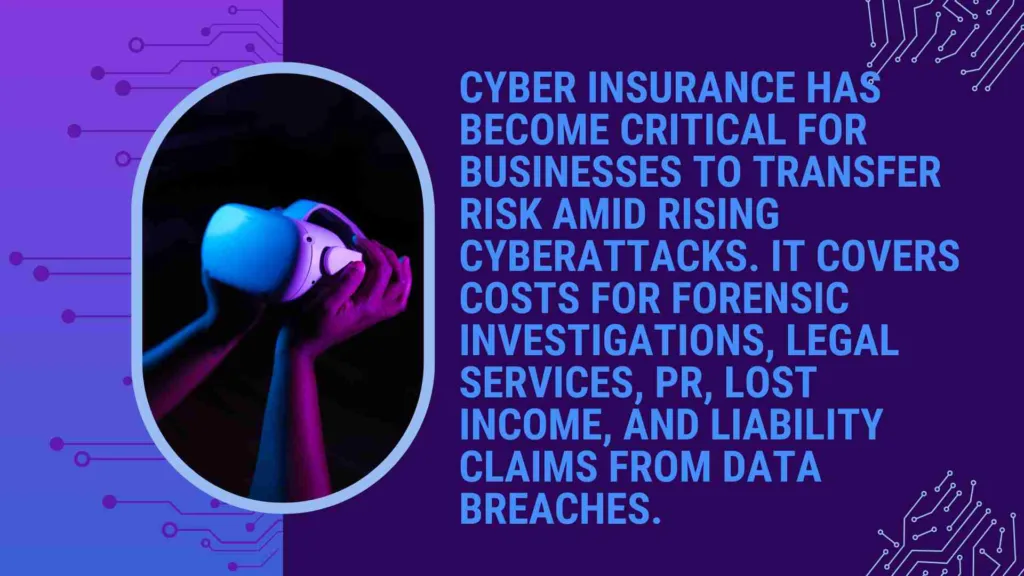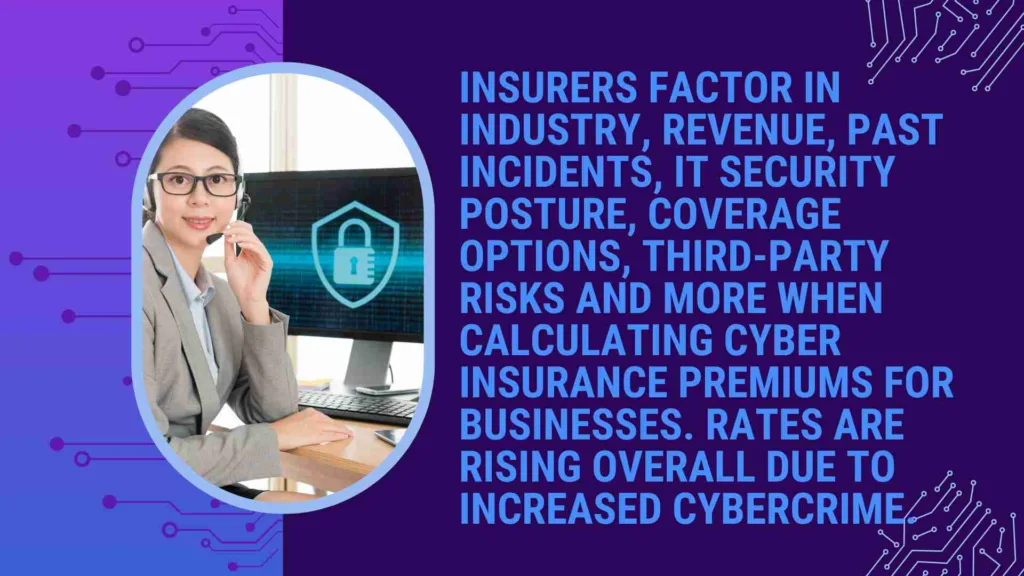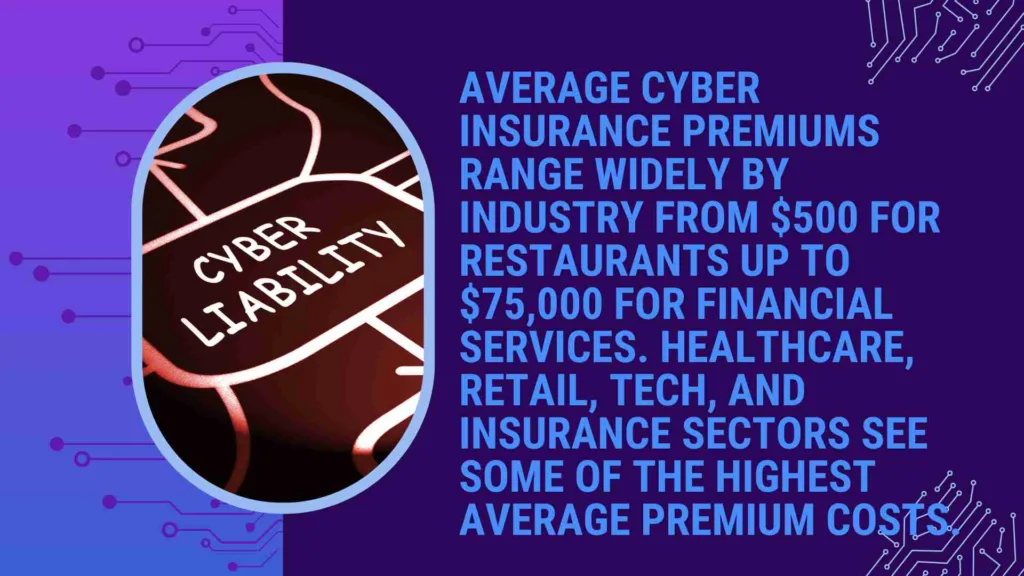Introduction
Cyber insurance has become an increasingly important topic for businesses of all sizes in recent years. As cyberattacks and data breaches continue to rise, many companies seek cyber insurance to help protect themselves. But how are cyber insurance premiums calculated? This comprehensive guide explains everything you need to know about how cyber insurance rates are determined in 2024.
Key Takeaways
- Cyber insurance has become crucial for businesses to transfer cyber risk, with premiums rising in 2024 due to increased attacks.
- Insurers calculate premiums based on industry, revenue, past incidents, security posture, coverage options, and third-party risks.
- Industries like healthcare, retail, and finance face the highest premiums due to sensitive data and regulations.
- Strong security controls like multi-factor authentication and encryption can reduce premium costs.
- Past cyber incidents leading to claims drive premiums upward based on higher risks.
- More extensive cyber insurance policies with added coverages have higher premium costs.
- Small businesses generally have lower premiums starting around $500 to $5,000 annually. Enterprise premiums can cost over $100,000.
- Partnering with an MSP for managed security services can help control premium expenses.
- Ongoing security improvements, risk management, and high deductibles allow organizations to optimize insurance value.
Table of Contents
Why Businesses Need Cyber Insurance

Before diving into the details of premium calculations, it’s helpful to understand why cyber insurance has become so critical for today’s businesses. Some key reasons include:
- Increasing cyber threats – From ransomware to phishing scams, cyberattacks are on the rise. According to FBI data, there was a 13% increase in cybercrime in 2021 compared to 2020. No business is immune to the growing threat of cyberattacks.
- Costly data breaches – The average data breach cost rose to $4.35 million in 2021, up from $3.86 million the previous year, according to IBM and the Ponemon Institute. The costs of a breach can quickly put a company out of business.
- Risk management – Cyber insurance helps businesses manage and transfer cyber risk. It provides coverage for expenses and losses resulting from cyber incidents.
- Business protection – Cyber policies cover a range of first- and third-party costs related to cyberattacks. This includes IT forensics, legal defense fees, liability claims, customer notification costs, and more. The right policy can be a lifeline for an impacted business.
Because virtually every modern business relies on technology and data, most experts recommend investing in cyber insurance. Statistics show over 90% of data breaches target small and medium-sized businesses. Cyber insurance can help safeguard any business from financial ruin.
How Are Cyber Insurance Premiums Calculated?

Cyber insurance providers take many factors into account when calculating premiums for policies. Some key considerations include:
Industry and business type – Businesses like healthcare, finance, and retail tend to have higher premiums due to heightened cyber risks and regulations. The size of a business also impacts rates.
Security measures – Insurers look at the strength of a company’s IT security defenses, policies, employee training, and more. Stronger security can lead to reduced premiums.
Prior incidents and losses – Any past cyber incidents, breaches, or insurance claims will drive premiums upward as they demonstrate higher risk.
Revenue size – Larger companies pay more for cyber insurance due to increased exposure. Revenue size helps determine appropriate coverage limits, too.
Third-party vendors – Businesses relying on third-party vendors or contractors have increased supply chain cyber risks that can increase premiums.
Coverage options – More extensive cyber insurance coverage usually translates into higher premiums. Minimum or basic coverage has lower premium costs.
Let’s look at each of these cyber insurance premium factors in more detail:
Industry and Business Type Risks
One of the biggest factors influencing cyber insurance premiums is the industry and business type seeking coverage. Businesses in sectors dealing with healthcare records, financial data, retail customer data, and other sensitive information face heightened cybercrime risks. Examples of industries with elevated premiums include:
- Healthcare organizations like hospitals, medical centers, clinics, and mental health providers
- Financial institutions such as banks, investment firms, accounting services, payment processors, and credit bureaus
- Retailers that collect and store customer data like e-commerce companies, department stores, supermarkets, etc.
- Technology companies such as SaaS providers, social networks, IT vendors, and web hosting services
- Utilities managing critical infrastructure like power, water, electric grids, nuclear facilities, dams, oil and gas providers, etc.
- Educational institutions, including K-12 schools, colleges, and universities that hold student and staff records
- Government agencies and public entities like municipalities, emergency services, social services, public transit, corrections, pension funds, etc.
These and other data-rich industries represent prime targets for cybercriminals. As a result, they often pay higher cyber insurance premiums compared to businesses with less sensitive data. Financial regulations also drive up costs for institutions like banks and healthcare systems.
Besides industry, the overall size of a business also impacts premium calculations. Small businesses generally have lower premiums than large enterprises. However, MSPs, small law firms, accounting firms, and other SMBs holding sensitive client data still face substantial cyber risks requiring coverage.
IT Security Posture Lowers Premiums
Cyber insurance providers closely analyze the strength of a company’s IT infrastructure and security defenses when assessing premiums. Businesses demonstrating robust cybersecurity measures and overall posture can qualify for discounts on insurance rates.
Some common IT security factors influencing premiums include:
- Regularly updated and patched systems
- Use of antivirus and anti-malware tools
- Firewall protections and intrusion prevention
- Secure remote access solutions like VPNs
- Encryption of sensitive data at rest and in transit
- Strong password policies and multi-factor authentication
- Backup and recovery systems for data and servers
- Employee cybersecurity training completion
- Cyber incident response plans and drills
- Vulnerability and penetration testing
- Compliance with regulatory and industry cybersecurity standards
Businesses showing proof of strong security controls like these are less likely to suffer a breach. This results in reduced risks and lower premiums. Cyber insurance audits may assess a company’s security posture before finalizing policies.
Ongoing security upgrades can lead to premium reductions at renewal time too. Partnering with an MSP or IT services firm to oversee security gives small businesses an advantage when securing coverage. Be sure to discuss any security improvements with insurance brokers.
Cost Impacts of Past Cyber Incidents
If a business has experienced data breaches or cyberattacks or filed insurance claims for past incidents, you can bet it will pay higher premiums. Past cyber events demonstrate higher risks. Insurance underwriters carefully review prior breaches, malware infections, fraudulent transactions, ransomware attacks, and other relevant incidents when pricing coverage.
Major past cyber incidents can make attaining coverage difficult altogether. Applicants must often demonstrate security improvements undertaken since past events to ease underwriting. Minor past cyber events generally cause small to moderate premium increases. Especially severe or repeated incidents could prompt larger premium hikes.
The key takeaway is that all organizations should carefully document cyber incidents when they occur. Tracking incident details helps when it comes time to apply for cyber insurance. Being transparent about past events lets insurers gauge risks and price coverage properly.
Revenue Size Equals Greater Exposure
Large companies usually pay higher cyber insurance premiums than small businesses. Revenue numbers help underwriters measure a business’s financial exposure to potential cyber incidents.
Larger enterprises tend to store more sensitive records, have more customers impacted during breaches, and have higher costs from operational disruptions. They typically need larger coverage limits to insure cyber risks adequately.
Here are some revenue size premium guidelines:
- Small businesses with less than $10 million in revenue have lower premiums ranging from $500 to $5,000 annually for basic coverage.
- Mid-size companies earning between $10 million and $250 million see more moderate premiums from $10,000 to $50,000+ based on other factors.
- Enterprise organizations with over $250 million in revenue have greater exposures leading to premiums from $100,000 up to millions for extensive coverage.
But revenue isn’t the only factor determining appropriate coverage limits. Even smaller businesses can opt for higher limits if their data or systems are deemed high-value by underwriters.
Third-Party Cyber Risks
Today’s businesses rely on third-party vendors, contractors, suppliers, and partners. Examples include cloud services, IT consultants, call center providers, payment processors, law firms, marketing agencies, CDNs, SaaS applications, and more.
But these third-party relationships also introduce cyber risks that must be considered when purchasing insurance. If a vendor or contractor suffers a breach, it can directly impact the business they serve.
Third-party risks compound the cyber threat for today’s interconnected businesses. Insurers may inquire about critical vendors during the application process. Premiums typically rise for businesses with greater dependence on third parties that access internal systems or sensitive data.
To reduce these risks, businesses should perform cybersecurity due diligence on partners via audits, questionnaires, and contract security provisions. Make sure vendors carry their cyber insurance, too.
More Coverage Equals Higher Premiums
Cyber insurance policies offer a modular approach with many types of coverage available. Organizations can mix and match coverage options to build a custom cyber policy suited to their needs and budget. More extensive policies cost more than basic, limited plans.
Some of the common cyber insurance coverages with added premium costs include:
- Extortion expenses related to ransomware attacks or cyber extortion threats
- Crisis management costs like PR services, legal expenses, third-party forensics
- Business interruption coverage for income losses and extra expenses from outages
- Bricking device coverage if hardware like computers are damaged by malware or hacking
- Media liability coverage in case hacked social media accounts are misused
- Funds transfer fraud if bank/finance accounts are compromised
- Telecommunications fraud coverage for phone hacking incidents or PBX system abuse
- Network security liability covering lawsuits related to the transmission of malware
- Paper records coverage for breach response costs when paper files are impacted
- Reputational harm coverage for losses stemming from brand damage after an incident
- PCI fines or penalties coverage if subject to card brand penalties after a breach
Businesses should carefully evaluate all policy options with insurance brokers when designing a cyber plan. Prioritizing essential coverages helps balance premium costs with adequate protection. Just be aware that higher limits and more optional coverages drive premiums upward.
Average Costs of Cyber Insurance by Industry

To give a sense of real-world cyber insurance costs, here are 2023 premium ranges for some common business types and industries:
- Healthcare – From $50/physician to $500k+ for hospitals and large clinics. Average around $25k.
- Financial – Range from $15k for an SMB accounting firm to $500k for large banks. Average around $75k.
- Retail – Approximately $1k – $100k based on revenue, locations, and e-commerce. Average $15k.
- Professional Services/IT – $500 – $50k depending on client data access and IT roles. Average $5k.
- Manufacturing – Wide range from $100 – $100k based on revenue and technology use. Average $7.5k.
- Insurance – Similar to Financial at $15k – $250k range. Average $50k.
- Real Estate – Anywhere from $250 for basic to $15k for title firms and large brokers. Average $2k.
- Restaurants – Tends to be lower at around $250 – $2k range due to low data collection—average $500.
- Construction/Trades – Lower end, too, at a typical $150 – $2k range. Average $800.
- Retirement Homes – $1k – $25k range depending on size. Average $5k.
- K-12 Schools – Average is $1k – $2k per school for districts.
- Transportation – Wide range based on freight vs. passengers from $2k – $150k. Average $10k.
These numbers showcase the variance in average cyber insurance costs across different industries. Premium calculation truly depends on the unique risks each business faces.
Other Factors Impacting Costs
While we’ve covered the major influences on cyber insurance premiums, a few other variables can impact costs:
- Claims history – Frequent past claims drive up premiums more than prior breaches.
- Coverage limits – Higher coverage for expenses or liability requires larger premiums.
- Deductibles – Businesses that accept larger deductibles pay smaller premiums.
- Insurer competition – A crowded cyber insurance market creates pricing pressure amongst carriers.
- Policy packages – Bundling cyber with other policies like E&O may provide discounts.
- Policy duration – Longer 1 to 3-year policy terms can offer lower rates than one year.
- Geographic location – Being located in cybercrime hotspots like California may increase premiums.
- Industry trends – Rates rise following spikes in claims within your particular industry or sector.
The Future of Cyber Insurance Pricing

Given the frequency and severity of cyberattacks continue to climb, all signs point to cyber insurance premiums increasing across the board in 2023 and beyond.
Ransomware incidents grew 13-fold from 2018 to 2021, fueling large claim payouts. Major cyber events like the 2021 Colonial Pipeline attack have cost insurers over $100 million in losses contributing to changing market dynamics.
Insurers will grow more cautious and tighten underwriting standards to restore profitability. Much higher premiums, even for basic coverage, are expected. According to experts, costs in niche industries like healthcare, retail, and education may double or triple over the next 1-2 years.
Businesses needing more solid security safeguards will likely face the largest premium hikes. Those able to highlight security improvements may fare better with more moderate increases.
While cyber insurance costs are projected to rise substantially, it remains necessary to be prepared. Partnering with an MSP for managed security services and compliance guidance can help firms control premium expenses.
Proactively applying risk management and loss control allows businesses to get the most value from cyber insurance during turbulent times. Firms should discuss projected changes with brokers to stay ahead of trends.
Frequently Asked Questions
How are premiums calculated for first-party cyber insurance coverage?
First-party policies cover the insured company’s losses from a cyber incident. Premiums are calculated based on potential costs for:
Cybersecurity forensic investigations
Legal services
Crisis management / PR
Network restoration
Lost income
Ransomware payments (if covered)
Other breach response and recovery expenses
Business size, industry, revenue, security posture, and past incidents inform appropriate first-party limits. Higher limits mean higher premiums.
What goes into pricing third-party cyber liability coverage?
Third-party cyber liability covers damages to others impacted by an incident at the insured company. Premiums are calculated based on potential expenses for:
Defending lawsuits by customers or clients
Settling legal claims and regulatory actions
Data breach notification costs
Financial losses incurred by third parties
PR firm fees
Credit monitoring services
Factors like customer counts, data types collected, security controls, and past legal exposures allow insurers to price third-party coverage properly. More customers and liability risks lead to higher premiums.
Do cyber insurance rates increase each year?
Insurance carriers review all policies at renewal time annually. Cyber premiums have largely increased at each renewal over the past 5+ years due to rising cybercrime. However, businesses demonstrating security improvements may avoid major increases. Rates can even decrease in some cases with lower risks. Firms should provide updated details on security posture annually to minimize premium hikes potentially.
How much does cyber insurance cost for a small business on average?
Small businesses with less than $10 million in revenue can expect basic cyber insurance premiums starting as low as $500 per year and up to $5,000 or more based on other factors. Average small business premiums often fall between $1,500 to $2,500. Specific costs depend on the insurer, coverage limits, industry, prior incidents, technology use, and security controls.
How can businesses potentially lower cyber insurance costs?
Top ways to potentially pay less for cyber insurance include:
Purchase appropriate coverage limits to avoid paying for unnecessary expenses
Accept higher deductibles in exchange for lower premiums
Complete employee cybersecurity training to reduce human risk
Implement multi-factor authentication across all systems and apps
Encrypt sensitive customer data both in transit and at rest
Maintain patched and up-to-date software, network gear, and devices.
Perform regular backups and disaster recovery testing
Carefully evaluate third-party vendors for sound security practices
Explore policy discounts for bundling multiple insurance products
Ask insurers for premium credits in return for implementing security upgrades
Prioritizing cybersecurity fundamentals allows businesses to maximize insurance value.
How can cyber insurance premiums be calculated?
Cyber insurance premiums are calculated based on several factors. These factors include the type of business, the size of the business, the industry the business operates in, the level of cyber risk associated with the business, the business’s cybersecurity measures and practices, and the desired coverage limits. Insurance companies use actuarial models and historical data to assess a cyber attack’s likelihood and potential cost and determine the appropriate premium for the coverage.
What is cyber liability insurance?
Cyber liability insurance is a type of insurance that provides coverage for costs associated with a cyberattack or data breach. It helps businesses protect against financial losses resulting from cyber incidents such as data breaches, unauthorized access, malware attacks, and ransomware. Cyber liability insurance can cover various expenses, including legal fees, notification costs, credit monitoring services, public relations efforts, and potential liabilities arising from third-party claims.
What is the importance of cybersecurity insurance?
Cybersecurity insurance is essential for businesses today because it helps mitigate cyber threats’ financial and reputational risks. It provides financial protection by covering data breaches, legal expenses, regulatory fines, and customer notification costs. Additionally, having cybersecurity insurance demonstrates a commitment to proactive risk management and can help attract potential clients and business partners who prioritize data security.
How do insurance companies assess cybersecurity risk?
Insurance companies assess cybersecurity risk by evaluating several factors, such as the business’s industry, data security measures, past cyber incidents, and the overall level of cyber risk associated with the business. They may also consider the type of data the business handles, the security controls in place, its vulnerability to cyber threats, and any prior cybersecurity training or certifications the business has implemented. The assessment helps insurers understand the potential exposure to cyber risk and determine appropriate coverage and premium costs.
What types of expenses can cyber liability insurance cover?
Cyber liability insurance can cover various expenses related to a cyber incident. These expenses may include legal fees, forensic investigation costs, customer notification expenses, credit monitoring services for affected individuals, public relations efforts to manage the company’s reputation, business interruption losses, and potential liabilities arising from third-party claims. The specific coverage and limits vary depending on the policy and the insurer.
Is cyber insurance worth the cost?
Whether cyber insurance is worth the cost depends on several factors, including the nature of the business, the level of cyber risk involved, and the potential financial consequences of a cyber incident. While cyber insurance premiums can be significant, the coverage can save a business from substantial financial losses and reputational damage in a cyber attack. Businesses need to evaluate their unique cyber risk exposure and consider the potential impact of such an incident when investing in cyber insurance.
What is first-party cyber liability insurance?
First-party cyber liability insurance covers expenses incurred by the insured business due to a cyber incident. This can include costs associated with breach response, crisis management, data restoration, business interruption losses, and other direct expenses. First-party cyber liability insurance helps protect the insured business’s assets and operations.
What is third-party cyber liability insurance?
Third-party cyber liability insurance covers costs arising from claims made by third parties due to a cyber incident. This can include legal fees, settlements or judgments, and other costs associated with defending against third-party claims for damages resulting from a cyber incident. Third-party cyber liability insurance helps protect the insured business from potential liabilities and lawsuits brought by affected customers, partners, or stakeholders.
How can cyber insurance help protect my business?
Cyber insurance can help protect your business by providing financial support and resources when dealing with the aftermath of a cyber incident. It can cover various costs, such as legal fees, forensic investigations, customer notification expenses, credit monitoring services, public relations efforts, and potential liabilities arising from third-party claims. Additionally, cyber insurance can offer access to cybersecurity experts and resources to help prevent and mitigate future cyber risks.
Q: What is the difference between cyber liability insurance and general liability insurance?
General liability insurance typically covers bodily injury, property damage, and personal injury claims resulting from accidents or negligence. On the other hand, cyber liability insurance specifically addresses costs and liabilities associated with cyber incidents, such as data breaches and cyber attacks. While general liability insurance may provide some coverage for cyber-related loss, it typically does not offer the comprehensive protection specifically tailored for cyber risks that cyber liability insurance provides.
What should businesses do to reduce their cyber liability risks?
To reduce cyber liability risks, businesses should adopt various cybersecurity best practices. These may include implementing robust data security measures, such as firewalls, encryption, and multi-factor authentication, regularly updating software and systems, educating employees about cyber risks and best practices, performing regular vulnerability assessments and penetration testing, and having an incident response plan. By proactively protecting their data and systems, businesses can minimize their exposure to cyber risks and potentially reduce insurance premiums.
Conclusion
The costs behind cyber insurance premiums are complex, but now you understand the key variables that drive pricing and answer the question, “How are cyber insurance premiums calculated.” While premiums rise substantially, cyber insurance gives organizations the confidence to survive incidents. Partnering with experienced insurance brokers allows companies to secure tailored coverage at competitive rates.
Staying vigilant with risk management and security prepares firms to weather the turbulent cyber insurance market in the years ahead. By prioritizing cyber resilience, businesses can control insurance expenses while being equipped to handle cyber disruptions.
- Does M&S Do Car Insurance? A Full Guide In 2024 - April 15, 2024
- Pet Insurance for Older Dogs: 2024 Full Guide & Top Providers - March 17, 2024
- Small Business Equipment Breakdown Insurance: Full Coverage - November 6, 2023

